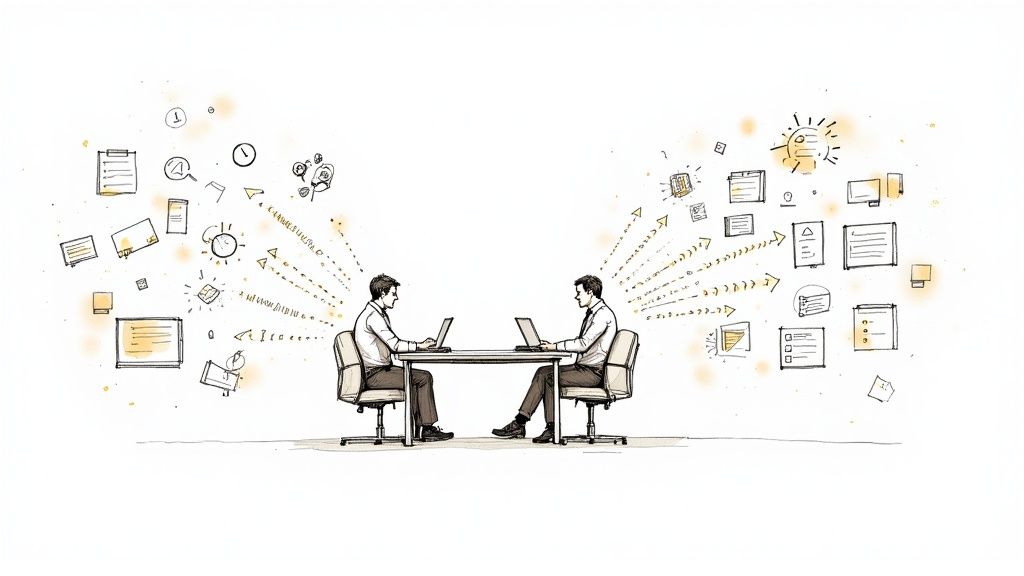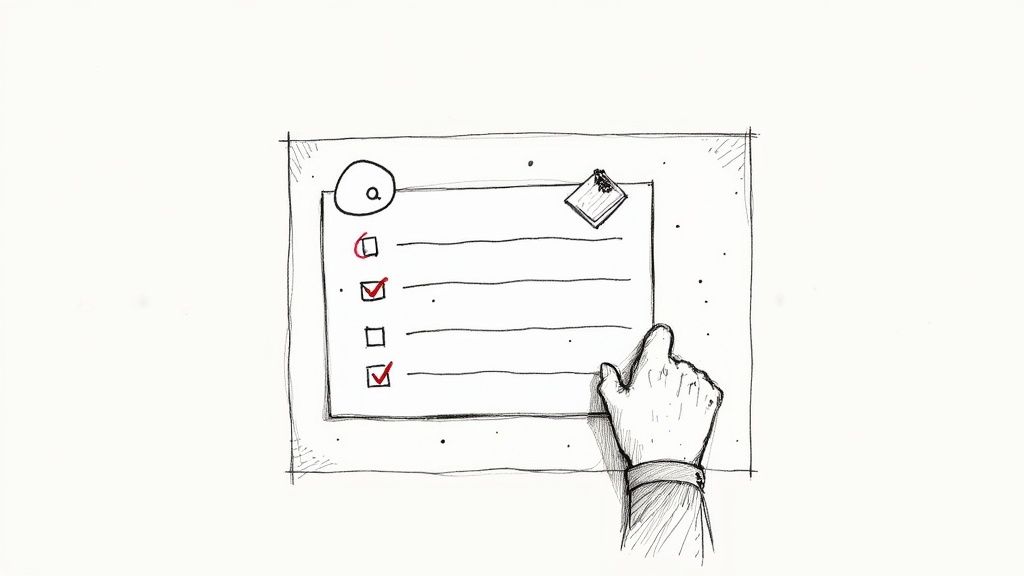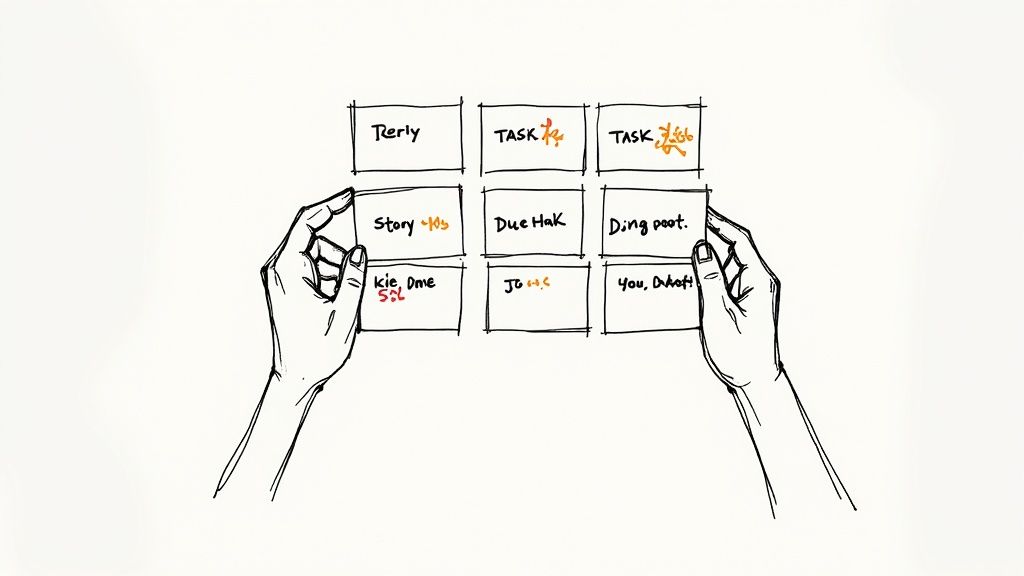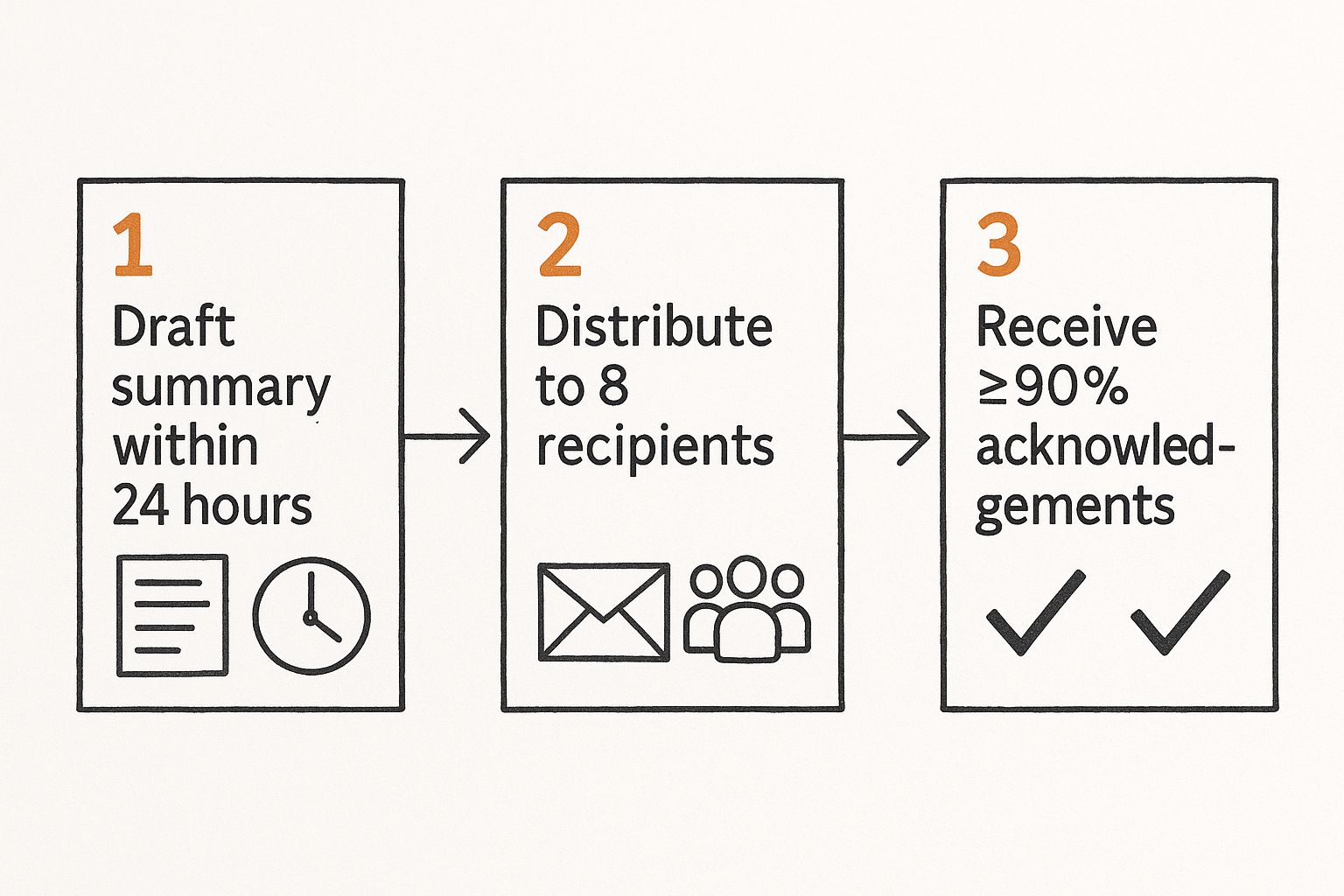First month for free!
Get started
Published 9/29/2025

The whole point of summarizing a meeting is to capture the important stuff: key decisions made, clear action items with names and deadlines attached, and getting those notes out to everyone within 24 hours. A great summary isn't a word-for-word transcript. Think of it more as a concise, actionable roadmap that keeps projects moving and ensures everyone is on the same page.

Meetings are a constant in professional life, but their value often evaporates the second the call ends. Without a solid record of what was decided and who’s doing what next, momentum dies and expensive time goes down the drain. This isn't just a minor annoyance; it has a real financial impact.
Believe it or not, ineffective meetings are estimated to cost U.S. companies a staggering $37 billion every single year. Beyond the sticker shock, there's the creeping cost of wasted time. The average professional loses about 91 minutes per workday to meetings and tasks that just don't matter.
It’s easy to dismiss writing a meeting summary as just another bit of administrative busywork, but that's a huge missed opportunity. In my experience, it's actually a powerful strategic skill that directly shapes project outcomes and team dynamics. A well-written summary turns a rambling conversation into a clear plan of attack.
Think about a project kickoff where the summary clearly stated that the marketing team, not sales, owned the final ad copy. That single sentence prevented a week of duplicated work and cross-departmental friction. On the flip side, I've seen the chaos that follows a budget review with no summary—two departments ended up paying for the same software license because nobody documented who was responsible.
A great meeting summary does more than just document the past; it actively shapes the future. It creates a single source of truth that builds accountability, reduces confusion, and ensures everyone moves forward together.
The difference a solid summary makes is night and day. Let's break down the tangible impact.
| Area of Impact | With an Effective Summary | Without an Effective Summary |
|---|---|---|
| Accountability | Action items are assigned with clear owners and due dates. Everyone knows their next steps. | Responsibilities are vague. Tasks fall through the cracks because "someone else" was supposed to do it. |
| Clarity & Alignment | Decisions are documented and accessible, creating a single source of truth for the entire team. | Misunderstandings and conflicting memories lead to confusion and rework. "I thought we decided..." becomes a common refrain. |
| Momentum | The team moves forward with confidence and purpose immediately after the meeting. | Progress stalls while people wait for clarification or try to remember what was agreed upon. |
| Time Savings | Reduces the need for follow-up meetings and clarification emails. | Precious time is wasted rehashing old conversations and tracking down decisions. |
Ultimately, a good summary ensures that the energy invested in a meeting actually produces something tangible. Mastering this skill is a cornerstone of any real effort to improve workplace communication and turn endless talk into measurable progress.

If you think great meeting summaries start when the meeting does, you're already behind. The real work begins long before anyone joins the call. Honestly, solid prep is what separates a frantic, useless transcript from a summary that actually drives action. It’s about being intentional, not just a passive observer.
Your first move, and it's non-negotiable, is to dig into the meeting agenda. Don't just skim the bullet points—really dissect it. What are the core objectives? What key decisions hang in the balance? This simple step immediately sharpens your focus and gives you a roadmap for what to listen for.
Then, think about your tools. Whether you're a fan of a slick digital app or a classic pen and paper, get your canvas ready. I’m a big believer in pre-formatting my notes with sections that mirror the agenda. It creates a structured space, so during the meeting, I'm just filling in the details rather than scrambling to build a structure from scratch.
Ever been in a meeting where the agenda felt a bit… vague? If you’re not crystal clear on the primary goal, don't just hope it becomes obvious later. Reach out to the meeting organizer beforehand.
A quick message can make all the difference: "Hey, just want to confirm—is the main goal here to decide on the Q3 budget or to brainstorm initial ideas?" This little bit of outreach can save everyone a ton of time and prevent you from summarizing the wrong things.
A summary is only as good as its inputs. Understanding the meeting's intended outcome before it starts is the single best way to ensure you capture what truly matters.
This proactive step aligns your focus with the organizer’s from the get-go. It’s how you guarantee your final document serves its real purpose instead of just recapping a conversation that missed the mark.
To put this into practice, here’s a quick mental checklist I run through about 15 minutes before any important meeting.
This isn't about creating more work for yourself. It’s about front-loading the effort. A few minutes of focused prep makes the entire process of summarizing the meeting faster, more accurate, and infinitely less stressful.

Alright, once the meeting kicks off, your job isn't to be a court stenographer. The single biggest mistake I see people make is trying to capture every single word. A word-for-word transcript is more than just overkill—it actually makes it harder to find the important stuff later. Your real mission is to pluck the signals from the noise.
This takes practice, but you have to train your ear to listen differently. Instead of getting lost in the conversational detours, you need to zero in on the destinations. Pay close attention to phrases that signal a decision has been locked in, an action item has been assigned, or a question has been formally tabled for another time. These are the gold nuggets you're mining for.
Think about our work lives for a second. The data is pretty sobering: the average employee sinks about 392 hours into meetings every year. That’s more than 16 full workdays gone. What's worse, a staggering 64% of recurring meetings don't even have a clear agenda, which makes your job of finding the key takeaways even more crucial. You can dig into more of these meeting productivity statistics on archieapp.co if you're curious.
To pull this off, you need a simple framework. As you listen, mentally (or physically) sort the information into three buckets: Decisions, Action Items, and Open Questions. This simple act of categorizing forces you to listen actively instead of just passively hearing.
When a final call is made, jot it down under "Decisions." Don't document the ten-minute debate that led up to it. Just capture the outcome. For example: "Decision: We will move forward with Platform Z for Q4." That’s it.
Action items, however, demand precision. "Look into budget" is useless. A proper action item has to be crystal clear. I always make sure it includes three things:
The single most important part of summarizing a meeting is capturing who will do what by when. Without this, your summary is just a historical document, not a tool for progress.
Don't be afraid to let technology be your backup. A simple voice recording on your phone can be a lifesaver when you realize you missed a critical detail. For really dense or technical discussions, AI transcription services can give you a searchable record, freeing you up to actually participate in the conversation instead of just typing frantically.
The key is to use these tools as a safety net, not a crutch. Your brain is still the primary filter. Your job is to listen, discern what’s important, and make sure the outcomes are captured clearly.
The meeting might be over, but your work isn't quite done. You’ve got a page full of notes, and now it's time to turn that raw material into something genuinely useful—a document that sparks action, not just fills an inbox. The trick is to do it fast, while the context and nuances are still fresh.
A truly effective summary is built for the reader. I always start with a super-short, one or two-sentence overview. What was the whole point of the meeting? This simple opener immediately grounds everyone and sets the stage for what matters most.
From there, I jump straight into the key decisions. This isn't the place to recount the back-and-forth debate; it's about clarity. Be direct and state the final outcomes without any fluff.
This is the most important part of the whole exercise: turning discussion into a solid plan. A meeting summary lives or dies by its action items. For any task to actually get done, it needs three essential ingredients:
If you miss any one of these, you’re creating ambiguity. Accountability evaporates when people aren't sure who's doing what or by when.
This workflow shows how to get your summaries out the door and working for your team quickly.

The emphasis is on getting it done, sending it out, and getting confirmation. Your summary should be a living tool, not a dusty archive.
Now it’s time to be brutal. Your mission is to make this summary as scannable as humanly possible. Slash jargon, delete filler phrases, and cut anything that isn't a core decision or a clear action.
A summary that takes more than five minutes to read has failed. Be relentless in your pursuit of brevity; your team will thank you for it.
Remember who you're writing for. Most meetings are for a specific, focused group. Research shows that while some meetings are huge, 27.6% have under 100 participants, and nearly half (49.4%) have between 101 and 500 attendees. This data, found in a UIA report on meeting demographics, confirms that you're not writing a novel for a mass audience. You’re giving a select group exactly what they need to move forward. Nothing more, nothing less.
https://www.youtube.com/embed/cST_Q5VpLRw
Let's be honest, manually writing a summary after every single call is a grind, especially on days packed with back-to-back meetings. This is where modern tools can be a game-changer, handing you back hours of your week by using AI to summarize a meeting almost instantly.
The concept is beautifully simple. You take a raw transcript from your meeting recording and feed it into an AI platform. Within moments, you get back a well-organized summary, complete with the main takeaways and a list of action items.
The biggest win here is speed. A task that might take you 30 minutes of focused work can often be done by an AI in less than one. This means you can get the notes out to your team while the conversation is still fresh for everyone.
It’s not just about being fast. AI brings a level of consistency that's tough to match, particularly at the end of a long day. It pinpoints key themes and decisions objectively, without being swayed by what one person found most interesting.
This is a lifesaver for really complex or technical discussions where getting the details right is crucial. An AI doesn't get distracted or miss that one critical point buried an hour into the conversation. For instance, tools like Mindstamp's Genie AI features are fantastic for pulling summaries directly out of video recordings.
Using AI for meeting summaries isn't about replacing human judgment; it's about augmenting it. It handles the heavy lifting of transcription and initial drafting, freeing you to focus on refining the key messages and ensuring accountability.
A typical workflow looks something like this:
This simple process turns a tedious chore into a quick final check, which makes it far more likely that every meeting actually gets the follow-up it deserves.
Even after you've got the basics down, a few practical questions always come up when you're trying to nail the perfect meeting summary. Getting these details right is often what separates a summary that drives action from one that just gets archived. Let's tackle some of the most common ones I hear.
Think fast. Your goal is a summary someone can digest in five minutes or less. For your typical hour-long meeting, that usually lands you somewhere in the 200-400 word range.
Remember, you’re not writing a court transcript. You're creating a quick-glance document that highlights the big takeaways. Brevity and clarity are your best friends here.
The golden rule is to send it while the discussion is still fresh. I always aim for within a few hours, but you absolutely want to get it out no later than 24 hours after the meeting wraps up.
Sending it quickly does two things: it keeps the details accurate and it helps your team maintain momentum. A fast summary shows that the meeting was productive and that there are real, immediate things to act on.
The heart of any good summary isn't what was said, but what needs to be done. Without clear action items, your summary is just a history lesson. With them, it's a roadmap for progress.
To make your action items count, make sure every single one has these three components:
This is where your neutrality is key. When the team doesn't reach a consensus or the conversation gets a little tense, your job is to report the facts objectively. Don't take sides or inject any emotional commentary.
For instance, instead of writing about a heated debate, you could phrase it like this: "The team discussed two approaches for the new marketing push: Option A (social media focus) and Option B (email campaign focus). The final decision was postponed until the follow-up meeting on Friday." This captures the situation perfectly without adding any fuel to the fire, establishing your summary as the trusted source of truth.
Ready to stop summarizing meetings manually? Lemonfox.ai provides a fast, accurate, and affordable Speech-to-Text API that turns your meeting audio into a clean transcript in minutes. Start your free trial and get 30 hours of transcription at https://www.lemonfox.ai.